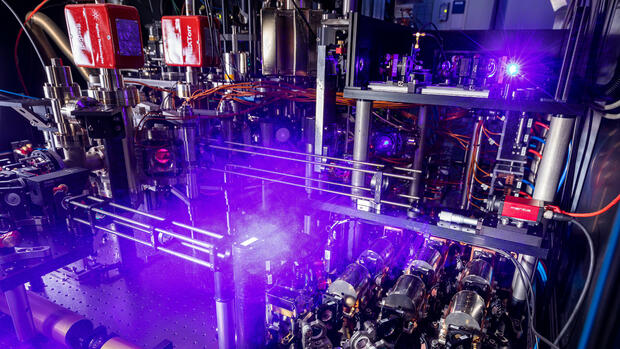Garching In Munich, the hope for a new key technology from Germany is growing. The quantum computer start-up Planqc, which was only founded in April, has collected 4.6 million euros from venture capital investors in a financing round. The founding team of scientists at the Max Planck Institute wants to develop a quantum computer based on top German research.
Hardly any future technology is associated with such great expectations. With their enormous computing power, quantum computers could accelerate the development of drugs, revolutionize materials research and guide cars through inner cities without traffic jams.
“As soon as our quantum computers show a quantum advantage for an industry-relevant problem, they will develop their enormous social and economic potential,” says Alexander Glätzle, CEO and co-founder of Planqc. So far, however, no one can say for sure whether and when humans will be able to build such computers – and which research approach is most promising for industry-relevant problems.
However, the rapid funding round is already important for the broad research and start-up landscape in Germany. It is often complained in Germany that innovative and large companies are rarely built up on top domestic research. Planqc is regarded as a beacon of hope that this can be systematically changed.
The young company is the first spin-off from the “Munich Quantum Valley”. The network of universities, research institutes and companies aims to bring world-leading research work into industrial application and especially to accelerate the founding of start-ups. 380 million euros from state and federal funds have been available for this since the beginning of the year.
Glätzle and his co-founders Sebastian Blatt, Johannes Zeiher and Lukas Reichsöllner work with atoms and laser beams. They are based on German basic research and the photonics industry, in which Germany is considered a world leader. In doing so, they are taking a completely different path than technology companies such as Google and IBM, which rely on superconducting chips and the semiconductor industry.
“A major goal of the Munich Quantum Valley is to find out in five years which quantum computing approaches are best suited for certain problems,” says Sebastian Blatt, “for example for optimization problems in business or for materials science.“
Google needs extreme cooling, Planqc works at room temperature
What the different approaches have in common is that they use so-called qubits instead of bits. Conventional computers calculate zeros and ones based on the unit of measure bits. The qubits of quantum computers, on the other hand, can take up an infinite number of values in between. This allows for much more complex computing operations.
The challenges are to manipulate the state of the qubits in a targeted manner and to keep them in certain positions. It is becoming apparent that superconducting chips are further along in development than experiments with neutral atoms. However, the approach of quantum opticians is considered less susceptible to interference.
And: While IBM and Google have to cool their quantum computers to temperatures close to absolute zero of minus 273.15 degrees Celsius at great expense, the experiments of the Max Planck scientists are running at room temperature. The atoms themselves are “more than a million times colder than space and over a thousand times colder than qubits used by IBM or Google,” says co-founder Johannes Zeiher. But due to the “almost perfect insulation” of the qubits, no cooling is necessary.
If you look at the experiments of the Munich scientists, you will see many small mirrors and laser beams. To understand how it works, you need knowledge of physics. Presented in a shortened form, their approach stores information in neutral – by nature identical – atoms. The electronic degrees of freedom of individual atoms are interpreted here as qubits. They are held and arranged in so-called optical grids of laser light. Arithmetic operations are performed by entangling the atoms with each other.
With the spin-off, the company wants to enable industrial applications and tests. “There are very good experiments on quantum information processing in the laboratory, but these experiments require an extremely controlled environment,” says Sebastian Blatt. For example, it is important how high the temperature and humidity are, so that no dust flies and vibrations are avoided. Planqc wants to further develop the technology in such a way that it also works outside a laboratory.
Companies should be able to test new quantum computers with the help of Planqc
“This kind of development cannot and should not be done by doctoral students at a research institution,” says Blatt. His start-up will now employ quantum engineers who will focus on the further development of the machines and make them available for pilot projects of companies.
There will be no error-free quantum computers with any method in the foreseeable future. Rather, research teams are working on ways to correct errors. Tommaso Calarco, Director of the Quantum Control Department at Forschungszentrum Jülich, explained at a scientific panel a few months ago that Google had already provided a good approach to this. For other platforms – such as those based on neutral atoms – such progress is still important. “It remains to be seen for which platform the accuracy achieved with error correction comes closest to that required for fault-tolerant quantum computers.“
The Planqc founders are being scientifically advised by Immanuel Bloch and Ignacio Cirac. The Max Planck Directors have contributed groundbreaking research on quantum simulation and quantum information and co-initiated the Munich Quantum Valley. “Over the past twenty years, we have done a lot of research in quantum technology in Europe, Germany and Munich, but we are not at the forefront of the quantum industry,” says Cirac. The scientist wants to help change this.
The Planqc founders also quickly found financial supporters. From the very beginning, the scientific founding team was also joined by multi-Supervisory Board member and economist Ann-Kristin Achleitner and serial entrepreneur Markus Wagner, who provided the company with start-up capital. The venture capital investors UVC Partners and Speedinvest are now leading the financing of EUR 4.6 million.









